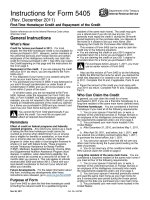Rich dirty little secrets; what the credit reporting agencies wont tell you (2013)
Bạn đang xem bản rút gọn của tài liệu. Xem và tải ngay bản đầy đủ của tài liệu tại đây (3.82 MB, 312 trang )
Table of Contents
Title Page
Acknowledgments
Preface
Introduction
CHAPTER 1 - Determining Your Current Financial and Credit Situation
What Is Debt?
Determining Your Current Financial Situation
So, Where Do You Stand Financially?
Identifying Credit Mistakes You’ve Made in the Past
Setting Your Financial Goals and Objectives in Today’s Economy
Your Financial Goals
What’s Next?
CHAPTER 2 - The Credit Reporting Agencies
What Is a Credit Reporting Agency, Anyway?
In Their Own Words . . .
What’s Next?
CHAPTER 3 - Credit Reports 101
A Preview of How Credit Scores Work
What Is a Credit Report?
The Anatomy of Your Credit Report
How the Information on Your Credit Report Is Compiled
Who Can View My Credit Report?
Why Your Credit Reports Are So Important
What’s Next?
CHAPTER 4 - Solving Credit Score Mysteries
Prepare to Get a Bit Confused by Credit Scores
Understanding Credit Score Ranges
E = MC Is a Complex Formula . . . Your Credit Score May Seem Just
as Complex
Credit Score vs. FICO Score: What’s the Difference?
What’s a VantageScore 2.0?
The Inside Scoop on FICO Scores from the Company that Calculates
Them
What’s Next?
CHAPTER 5 - Obtaining Your Credit Reports and Credit Scores
How to Request Free Copies of Your Credit Report Annually
Obtaining Your Credit Report Online
Submitting Your Request by U.S. Mail
Requesting Your Free Credit Report by Telephone
The Cost of Obtaining Additional or More Frequent Credit Reports
What About Your Credit Score?
The Benefits of a Three-in-One Credit Report
You Have Your Credit Report, Now What?
What Your Creditors Have to Say About Your Credit Report
Figuring Out What Needs to Happen Next
Misconceptions and Bad Information Can Lead to Costly Mistakes
What’s Next?
CHAPTER 6 - How to Update or Fix Your Credit Report
Reviewing Your Credit Reports
The Types of Information That Can Be Removed from Your Credit
Reports
How to Correct Errors Listed in Your Credit Reports
Initiating Disputes with the Credit Reporting Agencies
Negotiating with Your Creditors
Know Your Legal Rights as a Consumer
Working with a Credit Counseling Company
Meet Collections Expert Michelle Dunn
What’s Next?
CHAPTER 7 - Ten Strategies for Improving Your Credit Rating
Your Actions Always Impact Your Credit Worthiness
Strategies for Improving Your Credit Rating
Strategy 1: Pay Your Bills on Time, Every Time
Strategy 2: Keep Your Credit Card Balances Low
Strategy 3: Having a Long History Counts, So Don’t Close Unused
Accounts
Strategy 4: Only Apply for Credit When Needed, Then Shop for the
Best Rates on ...
Strategy 5: Separate Your Accounts After a Divorce
Strategy 6: Correct Inaccuracies within Your Credit Reports and
Make Sure Old ...
Strategy 7: Avoid Too Many Hard Inquiries
Strategy 8: Avoid Bankruptcy, If Possible
Strategy 9: Avoid Consolidating Balances onto One Credit Card
Strategy 10: Negotiate with Your Creditors or Collection Agencies
Avoiding Credit Repair Scams
Learn How to Better Manage Your Finances and Expenses
Advice from a Credit and Debt Counseling Expert
What’s Next?
CHAPTER 8 - Credit Card Management Strategies
Credit Cards Can Be Your Best Friend or Biggest Credit Foe
What Are Credit Cards?
The Potential Benefits of Credit Cards
The Potential Drawbacks of Credit Cards
What to Consider Before Using a Credit Card
Types of Credit Cards
Using Credit Cards Intelligently
Credit Card Lingo You Should Understand
Shop Around for the Best Credit Card Deals
Managing Your Existing Credit Card Accounts
Take Advantage of Special Balance Transfer Offers
Should You Consider Debt Consolidation?
What to Do if Your Credit Card(s) Get Lost or Stolen
Advice from Experts Representing Three Credit Card Comparison
Websites
What’s Next?
CHAPTER 9 - Finding and Obtaining the Best Rate on an Auto Loan
What Happens If You Don’t Pay?
Understanding Your Credit History
Your Credit Reports and Credit Score Directly Impact Vehicle
Financing
Shop Around for the Best Vehicle Financing Options
Vehicle Financing Options for People with Bad Credit
What’s Next?
CHAPTER 10 - Finding and Obtaining a Mortgage
Pre-Qualifying for a Mortgage Makes Sense
There Are Many Reasons to Pre-Qualify for a Mortgage
Finding a Mortgage Broker or Lender
What Is a Mortgage Broker?
Fewer Mortgage Options Are Available These Days
Money-Saving Strategies for Mortgage Shoppers
Pre-Qualification vs. Pre-Approval
You’re Pre-Qualified or Pre-Approved, Now What?
What If Your Application Gets Rejected?
What’s Next?
CHAPTER 11 - All About Refinancing in a Tough Economy
How Recent Changes in the Mortgage Industry Will Impact You
Refinancing 101
Popular Reasons Why People Choose to Refinance
The Paperwork You’ll Need to Refinance
Meet Greg McBride, Bankrate.com’s Senior Financial Analyst
What’s Next?
CHAPTER 12 - Getting the Help You Need to Fix Your Credit Problems
Being too Proud to Ask for Help Can Lead to Worse Problems
Solutions for People with Credit and Financial Problems
Strategies for Finding a Qualified Financial Planner
Credit Counselors Are Available to Help You
Beware of Scams
Debt Consolidation May Be a Viable Option
Don’t Be Afraid to Seek Help
Advice from a Certified Financial Planner
What’s Next?
CHAPTER 13 - Identity Theft and Bankruptcy Two Credit Rating Killers
to Avoid
How Many People Out There Are Posing As You?
Watch Out! Identity Theft Is the Fastest Growing Crime in America
How Criminals Obtain Your Private Information
You May Already Be a Victim of Identity Theft and Not Even Know It
What to Do if You Become an Identity Theft Victim
Consider Using An Identity Theft Prevention Service
Meet Todd David, CEO and Founder of LifeLock
Thoughts About Bankruptcy from an Attorney
What’s Next?
CHAPTER 14 - Managing Your Finances There’s an App For That
Mint.com Is an Online and App Tool
Manage Your Credit Cards with a Smartphone App
Now It’s Your Turn . . .
Glossary
Index
Subscribe to Entrepreneur Magazine
Copyright Page
Acknowledgments
Thanks to Leanne Harvey, Randy Ladenheim-Gil, and Ronald Young at
Entrepreneur Press for inviting me to work on this project. Thanks also
to Karen Billipp at Eliot House Productions for her help in editing and
designing this book.
I’d also like to thank my family and close friends for their ongoing
love and support, and express my gratitude to you, the reader, for
picking up and reading a copy of this book.
To visit my website, point your web browser to www.JasonRich.com, or
you can follow me on Twitter @JasonRich7.
PREFACE
Discover Why Your Credit Rating Is So Important
We’re living in challenging financial times. It’s harder than ever for
someone, even with average credit and a steady job, to get approved
for a mortgage, or even receive a good deal when applying for a new
credit card or car loan.
As a result, it’s become essential that Americans take a proactive role
when it comes to responsibly managing and protecting their credit
rating. This is not something that the credit reporting agencies (credit
bureaus), banks, financial institutions, credit card issuers, the
government, or even your own accountant will do for you or on your
behalf.
Yet, few people truly understand how to properly manage and protect
their credit rating. Even fewer people comprehend exactly how
essential it is to build and maintain above-average credit scores.
The information within your credit reports that are compiled by the
three credit reporting agencies (credit bureaus)—Equifax, Experian,
and TransUnion—combined with your numeric credit scores (which are
calculated based on the information published within your credit
reports) have a direct impact on almost every aspect of your financial
life.
For example, your credit scores directly impact:
■ Your ability to obtain a mortgage or refinance your mortgage, as
well as get approved for any type of home equity loan (or home
improvement loan)
■ A landlord’s application approval decision if you’re looking to
rent a home or apartment
■ Your chances of being approved for an auto loan
■ Your ability to get an application approved for any type of credit
card
■ Whether or not you’ll be able to obtain student loans for yourself
or your children
■ Whether or not you’ll be approved for many types of insurance
policies
■ A potential employer’s decision to hire you
If you do get approved for any type of credit or loan, your credit
scores (and the information within your credit reports) will impact
what interest rate you pay and how much you’ll pay in fees to that
creditor or lender over time. As a general rule, the lower your credit
scores, the greater risk you pose to a potential lender. Thus, you’ll
wind up paying significantly higher interest rates and fees, if you’re
even granted credit or approved for a loan, than someone with aboveaverage or excellent credit scores. In the case of credit cards, you’ll
also be offered a lower credit limit and fewer cardholder benefits.
Earning a credit rating that’s classified as below average could easily
cost you hundreds, perhaps thousands of dollars every month in
interest charges and fees when you add up how much extra you’re
paying your lenders and creditors for your mortgage, car loan(s),
credit card(s), student loans, etc.
Building and maintaining above-average credit scores will save you
money, plus make it significantly easier to get approved for the credit
and loans you want or need in the future. Contrary to popular belief,
building and maintaining high credit scores and protecting your credit
rating isn’t difficult or terribly time consuming once you understand
exactly how the process works (which is something you’ll learn from
this book).
Yet, going through your adult life being oblivious to how the credit
reporting agencies, credit reports, and credit score systems work will
most likely result in costly mistakes that will impact your financial
well-being for many years in the future.
Are you aware that a mistake you make (or an irresponsible financial
behavior you practice) that leads to a negative impact to your credit
rating will most likely remain on your credit reports and continue to
negatively impact your credit scores for seven to 10 years?
Knowing what the credit reporting agencies do, how they work, and
what goes into calculating your credit scores, for example, is the first
step toward building, maintaining, and protecting your credit rating.
Plus, cleaning up the credit mistakes you’ve already made, practicing
responsible spending habits moving forward, and properly utilizing
your existing credit on an ongoing basis will help to ensure an aboveaverage credit rating now and in the future.
Dirty Little Secrets offers easy-to-understand advice and information
about:
■ Credit reports and how they’re compiled
■ Credit scores and how they’re calculated
■ How the credit reporting agencies work (and their relationship to
your creditors, lenders, insurance companies, employer, and
banks)
■ Working with lenders and creditors without overpaying interest
charges and fees
■ Successfully working with collection agencies, creditors, and
lenders to pay off debts and overcome past mistakes (without
further destroying your credit rating or becoming a victim of
harassing phone calls from collection agencies)
■ Overcoming past credit and financial mistakes to rebuild your
credit rating
■ Maintaining and protecting your credit scores and overall credit
rating
■ Understanding the relationship between your credit scores, your
credit reports, and your ability to obtain credit and loans
(including mortgages, car loans, student loans, home equity
loans, credit cards, etc.)
■ How to get approved for the loans and credit you want and need
■ Building and improving your overall credit rating and credit
scores
■ Using computer software and online banking, plus easy-to-use
apps on your tablet or smartphone (such as an iPhone) to help
you better manage your finances, credit cards, spending, and billpaying schedule
■ Working with a legitimate credit counseling agency if you’ve
already run into serious trouble and need assistance rebuilding
your credit and getting yourself out of significant debt
Regardless of who you are, how much money you earn, what you do
for a living, where you live, your marital status, or your ability to save
money, it’s absolutely essential that you develop a thorough
understanding of how to build, improve, maintain, and protect your
credit rating. This includes the information that’s published within
your credit reports and paying close attention to your corresponding
numeric credit scores.
As you’ll discover from this book, you don’t have to become a financial
guru or a wiz at math to improve your overall credit rating or boost
your credit scores. This book is chock full of advice, tips, strategies,
and easy-to-understand information that you can start applying
immediately in order to rebuild, improve, protect, and/or maintain
your overall credit rating.
By reading this book, you’ll discover secrets for saving money,
starting immediately—on your existing loans and credit cards, for
example—plus you’ll learn how to save a fortune in the future by being
more credit savvy. You’ll also learn to avoid the most common financial
and credit-related mistakes that millions of Americans make that lead
to destroying their credit rating and wind up costing them a fortune.
If you’re in the process of shopping around for a mortgage (to
purchase a new home), or you’re looking to refinance your existing
mortgage, your credit scores and the information within your credit
reports will have a huge impact on your ability to obtain an approval
from a lender, plus directly impact how much you’ll pay in fees and
interest charges.
Not only does this book teach you how to find and work with a
reputable mortgage broker/lender in order to save money, it offers
proven strategies for saving money when acquiring or refinancing a
mortgage by first working to improve your credit scores and overall
credit rating before you start the application process.
Dirty Little Secrets will also help you avoid the many “credit repair”
and credit score boosting scams that are out there. Regardless of what
some ads for credit repair services tell you, if you’ve managed to
destroy your credit rating, it could realistically take you three, six or
12 months (perhaps several years) to legally rebuild your credit rating
and dramatically improve your credit scores. This is not something that
can be done quickly and it requires effort on your part.
While this book will teach you how to repair and improve your
overall credit rating and credit scores as quickly as possible, it offers
no overnight solutions, especially if you’ve already made serious
financial or credit-related mistakes that you first have to recover from.
Thus, it’s important that you approach your credit repair efforts with
realistic expectations.
No matter what financial or credit situation you’re currently facing,
this book will help you improve it, plus teach you how to save money
and become more responsible with your credit management practices.
But, as you learn the financial and credit management secrets and
strategies that are revealed, it’s essential that you begin applying
them in a well-organized and consistent manner in order to generate
the best results in the shortest amount of time possible.
Your ongoing commitment will be required if you want to achieve
success and enjoy an above-average credit rating and the moneysaving perks and benefits that go along with this status.
INTRODUCTION
Understanding How Credit Works Can Save You
Money
If you examine current statistics relating to American consumers’
reliance on credit cards, the number of home foreclosures taking place
every month, and the percentage of people who are being forced into
bankruptcy due to poor financial management or circumstances (such
as job loss) that are beyond their control, the country’s economic
situation looks bleak.
The Federal Reserve Bank reports that 40 percent of American
families currently spend more than they earn. Are you one of these
people? Have you gotten yourself in over your head financially?
Obviously, nobody wants to be known among their creditors and
lenders as a deadbeat. Few people intentionally set out to accumulate
so much debt that it becomes virtually impossible for them to
eventually pay it off and get back on their feet financially. Yet, every
year, millions of people find themselves experiencing dire financial
problems.
These problems might be a result of your own irresponsible actions,
or they could have occurred in whole or in part due to situations
beyond your control (such as job loss due to downsizing, medical
injury, long-term illness, divorce, death of a spouse, or being a victim
of identity theft). Whatever the cause of your current financial
problems, the end result will be the same.
While you may be feeling embarrassed or ashamed at your current
predicament, it’s important to understand that you are not alone, and
that there are ways to remedy the situation over time. Furthermore,
there are legitimate resources at your disposal that can provide
affordable (sometimes free) guidance, if you make the effort to seek it
out before it’s too late.
As of March 2012, 46.7 percent of all American households maintained
some type of balance on their credit cards. The average credit card
balances in indebted households totaled $14,517 (versus $6,772 in
average credit card debt in average American households). While this
figure is actually an improvement from statistics from two years
earlier, if you’re one of those households juggling more than $14,500
in credit card debt, among your other debts, the amount of money
you’re paying in interest charges and fees is probably financially
debilitating.
It’s important to understand that while Americans are relying more
and more on credit cards, the credit card issuers are generating record
revenues as a result of fees and interest charges. In fact, the total
amount of revolving credit card debit in America (as of March 2012) was
$803.6 billion.
What Do You Believe About Your Debt?
Bankrate.com asked consumers a series of separate questions
related to how credit works, and the results were somewhat
alarming. According to Bankrate.com, “66 percent of Americans
say debt is often the result of unfortunate circumstances
beyond a person’s control, while 60 percent say it is usually the
result of bad decisions . . . . While 91 percent believe debt can
be controlled by disciplined saving and spending, 72 percent
also believe that debt is a part of modern life and difficult to
avoid.”
The number of people facing credit and financial problems is also on
the rise, thanks to a generally poor economy, the troubled real estate
market, rising gas prices, nationwide inflation, and carelessness when
it comes to managing personal finances and credit. Lack of credit
knowledge (something this book will help remedy) is also a key factor
related to the cause of many people’s financial woes.
Plenty of people simply mismanage their finances, can’t control their
spending, and choose to live beyond their financial means by
overutilizing credit cards until they’re maxed out. Whatever the
reason is for your financial woes, it’s important to take the following
steps in order to begin remedying your situation:
1. Carefully analyze your credit rating and overall financial
situation so you know exactly where you stand right now.
2. Develop a comprehensive plan to begin fixing the problem.
3. Begin paying your bills on time, and simultaneously pay off pastdue accounts to reduce your outstanding debt.
4. In the months and years ahead, stick to your plan to ensure a
positive outcome.
5. Learn how to prevent a similar situation from happening again
and take the necessary financial planning and budgeting steps to
ensure you’ll remain financially stable in the future.
As if experiencing financial problems isn’t enough, it’s important to
understand how these problems can and ultimately will lead to credit
problems over the long term. When you begin paying your bills late,
skipping mortgage payments, and/or overutilizing your credit cards,
for example, this information gets reported to the credit reporting
agencies (formally known as credit bureaus). Negative information in
turn gets added to your credit reports.
The information within your credit reports is then used by the credit
reporting agencies and other parties to calculate your credit scores. To
confuse the situation, a company previously called Fair Isaac
Corporation and now called FICO calculates the FICO Score of all
Americans with a credit history, while other third-party companies
calculate credit scores as well. Each credit reporting agency also
calculates its own credit score using proprietary formulas. You’ll learn
the difference between these different credit scores and how they
impact your ability to obtain credit (in the form of a credit card, any
type of loan, or a mortgage, for example) in Chapter 4. Your credit
scores are ultimately utilized by your current and potential lenders
and creditors to determine your credit worthiness.
Not Everyone In America Has Good Credit
According to CardHub.com, as of late 2011, 6.2 percent of all
Americans with a credit rating had a FICO credit score between
300 and 499 (the lowest possible scores), 8.7 percent had a FICO
credit score between 500 and 549, 47.4 percent had an
“average” FICO credit score of between 550 and 749, 19.4
percent had a FICO credit score between 750 and 799, and only
18.3 percent of the population had the highest possible FICO
credit scores (in the range of between 800 and 850).
People with excellent credit always get offered the very best credit
card, loan, and financing offers with the lowest fees and interest rates
associated with them. Those who have developed average or belowaverage credit wind up paying much higher fees and interest rates in
order to obtain the same credit card and lending privileges as someone
with excellent credit (someone with a history of paying all their bills
on time and successfully managing their debt).
People who ultimately destroy their credit rating and earn below-
average credit scores will wind up being denied credit and loans,
which means obtaining credit cards, a mortgage, student loans, car
loans, home equity loans, home improvement loans, store financing, or
other types of credit becomes either impossible or extremely costly.
Even if you have a mortgage, but wish to refinance, if your credit scores
have dropped to “below average” or worse, you’ll have an extremely
difficult time getting approved these days.
Because we’re living in a society that relies so heavily on the use of
credit, it’s vital that you learn how to properly manage the credit you
have, protect your credit rating, build a positive credit history, and
discover how to best utilize your available credit in the future.
If you’ve already made mistakes that have led to poor credit scores
and negative information appearing on your credit reports, it’s
important to begin taking steps to fix the situation. The negative
information currently listed on your credit reports could remain there
for seven to ten years (or longer) and impact your future financial
stability for many years to come.
From this book, you’ll learn how to analyze and then improve upon
your personal credit situation; discover the steps to take when
preparing to apply for a mortgage (or refinance), car loan, or some
type of major purchase; and you’ll learn where to turn for help if your
credit situation has gotten so far out of control that you don’t have the
knowledge or resources to turn the situation around yourself. You’ll
also discover how to utilize computer software, online banking, and
apps on your tablet or smartphone to help you better manage your
finances and protect your credit rating.
Finally, this book offers a handful of in-depth interviews with credit
experts. From these people, you’ll discover insider tips for managing
your credit, improving the information listed within your credit
reports, and strategies for boosting your credit scores over time.
Don’t be fooled! Managing and, if necessary, rebuilding your credit
can be a complex and sometimes confusing process. It’s also something
that can seldom be done quickly. This book will teach you exactly what
to do to improve your credit situation and properly manage your
credit, but if your credit scores have already dropped to a “below
average” or “poor” classification, for example, it will realistically be
many months or potentially several years before you can expect your
credit scores to raise to an “above average” or “excellent”
classification.
Your Spending Habits Will Impact Your
Credit Rating
The American Bankers Association published findings from a
survey that concluded that less than half (48 percent) of all
college upperclassmen believed their spending habits would
impact their credit rating in the future—one of many
misconceptions that often leads to low credit scores and a poor
credit rating.
You’ve probably seen all kinds of ads for companies that can quickly
“repair” your credit or have negative but accurate information
permanently removed from your credit reports. The reality of the
situation is these services are often scams or companies perpetuating
some type of fraud. From this book, you will learn the process for
having your credit reports modified, discover what information can be
changed, and how to go about getting your credit reports corrected or
updated by properly negotiating with your creditors and lenders, or by
initiating legitimate disputes with the credit reporting agencies when
it’s appropriate.
From this book, you’ll also learn the terminology you need to
properly manage your credit, plus learn about a wide range of free and
inexpensive resources available to you online that will help you
discover even more about properly managing and rebuilding your
credit.
The “Credit Tip” and “Warning” scattered throughout this book will
help bring important money- and time-saving information to your
attention, plus help you avoid common mistakes consumers make when
dealing with credit-related issues.
What you won’t learn from this book is how to manage your personal
finances, balance your checkbook, manage your investments, or develop
and implement a personal or family budget. This book exclusively
focuses on building, rebuilding, and maintaining a good credit rating.
Dirty Little Secrets was written to provide you with an introduction to
the importance of credit and how credit fits into your financial life.
This book will provide you with the core information you need, but it’s
only a start. As you’ll discover, building, rebuilding, and/or
maintaining good credit will require an ongoing effort and careful
planning on your part. While there are many quick and easy strategies
you can use to “fix” some credit-related problems, in order to ensure a
good or excellent credit rating, you’ll need to adopt a responsible
approach to your spending, money management, and credit
management techniques.
It’s important to understand that changes are always happening in
the credit industry and that the credit reporting agencies, creditors,
lenders, banks, and other financial institutions are always adapting.
Even the complex mathematical formulas used to calculate your credit
scores are constantly being modified to reflect the latest consumer
trends, economic conditions, and the needs of creditors and lenders.
We’re living in tough economic times, which makes it much more
difficult than ever for someone to get approved for any type of
mortgage or refinancing offer. Even credit cards, car loans, student
loans, home equity loans, and other types of credit are now much more
difficult to get approved for, even if your credit score is classified as
“average” or better.
Home Foreclosures Are Becoming Too
Commonplace in the U.S.
In April 2012 alone, there were approximately 66,000 completed
foreclosures nationwide. Nearly half (49.1 percent) of those
foreclosures took place in California, Florida, Michigan, Texas,
and Georgia. Meanwhile, there were 69,000 completed
foreclosures in March 2012, and 66,000 completed foreclosures
in February 2012.
Statistics show that approximately 1.4 million homes, which
translates to about 3.4 percent of all homes with a mortgage,
were in the national foreclosure inventory as of March 2012.
According to recent statistics, one out of every 622 homes in America
is actively being foreclosed upon. The Mortgage Bankers Association
reports that this translates to roughly 250,000 new families entering
into foreclosure every three months. Just as alarming is that in a
survey conducted by Freddie Mac/Roper, 6 out of 10 homeowners
wished they understood the terms and details of their mortgage better.
There’s no better time than the present to begin securing your
financial future by building, rebuilding, and properly managing your
credit. This book will show you exactly how this can be done, even if
you don’t consider yourself to be financially savvy and typically have
trouble balancing your checkbook.
CHAPTER 1
Determining Your Current Financial and Credit
Situation
What’s in This Chapter
■ Understanding what debt is
■ Determine your current financial situation
■ Planning your short- and long-term financial goals and
objectives
This book is all about understanding credit—how to obtain it, utilize it,
manage it, and avoid getting financially devastated by it. To make the
best use of credit, without overpaying for it, it’s important to
understand your relationship with creditors and lenders; the purpose
of the three credit reporting agencies (formally known as credit
bureaus); what credit reports are all about and what’s contained
within them; and the impact your numeric credit scores have on your
overall credit rating, as well as your ability to acquire credit and get
approved for loans.
Building a solid credit rating (and achieving high credit scores)
takes time, yet it’s possible to utterly destroy your credit rating (and
see your credit scores nosedive) as a result of just one month’s worth
of financial indiscretions and mismanagement. Missing a mortgage
payment, paying credit card bills late, or allowing any type of bill to
get turned over to a collection agency will all have an almost
immediate negative impact on your credit rating and credit scores.
Warning
Negative information that’s placed on your credit reports will
remain there for at least seven years and continue to
negatively impact your credit scores and overall credit rating.
However, as these negative items get older, they’re weighed
less heavily in your credit score calculation.
Information about you as a consumer, your relationships with your
creditors and lenders, and your utilization of available credit is
information that’s maintained within your credit reports, which are
compiled by Equifax, Experian, and TransUnion—the three credit
reporting agencies that you’ll be learning more about shortly.
Based on information that appears in your credit reports, which are
constantly being updated based on new information being reported to
the credit reporting agencies by your lenders and creditors, your
credit scores are then calculated. Again, how this all works will be
explained shortly.
What you need to understand right now, however, is that any
negative information that appears in your credit reports stays there
for at least seven to ten years. So, to fully understand your financial
situation, you’ll need to take a look at your past and present as you
plan for your financial future.
This chapter will help you gather information about your financial
past and determine how it’s impacted your credit rating to date. Once
you understand where you are right now from a financial standpoint,
you can better make plans for your future by setting realistic goals.
Once you understand where you’ve been, where you are now, and
where you want to be in the future from a financial standpoint, the
next focus of Dirty Little Secrets is to help you understand how credit
works, improve your credit situation, and fully utilize your available
credit without overpaying for it. One of the major goals of this book is
also to help you avoid the common mistakes people make when it comes
to utilizing and managing their credit.
What Is Debt?
When you utilize credit or acquire a loan, you take on debt. Debt is
simply borrowed money that eventually needs to be paid back (typically
with interest). Whether the amount borrowed is secured or unsecured,
or for a long or short term, when you borrow money for whatever
reason from a creditor, lender, or even your best friends, you’re
acquiring debt.
There are many types of debt. When you acquire debt by borrowing
money from a bank or financial institution, for example, there are
always fees, interest charges, and/or finance charges associated with
it. It’s these fees that allow lenders, creditors, banks, and other
financial institutions to earn money (and often huge profits).
Acquiring debt potentially allows you to spend more money than you
currently have on hand (stored under your mattress or in your bank
accounts) in order to purchase something you couldn’t otherwise
afford. In some cases, you can actually utilize debt to your advantage
in order to leverage the money you already have, but more on that
later.
Avoid Costly Payday Loans Whenever Possible
People who wind up with a poor credit rating are sometimes
forced to utilize short-term “payday loans” to cover their living
expenses. This is one of the most costly ways to borrow money.
A payday loan is a short-term loan, typically for a small amount
of money, that is offered at an extremely high interest rate, and
that typically has high fees associated with it. The way this
process works is that the borrower writes a personal check to
the lender, who agrees to hold onto it (without cashing the
check) until the borrower’s next payday (a period that typically
ranges between one and four weeks).
The borrower receives cash immediately for the amount of the
post-dated check they’ve written, but must pay a fee of $17.50
(or more) for every $100 borrowed. This can translate to an
interest rate of 911 percent for a one-week loan, 456 percent
for a two-week loan, or 212 percent for a one-month loan.
People who use payday loans are often already in serious debt
and experiencing financial problems, and ultimately wind up
having to take out additional payday loans to cover earlier
ones, placing themselves in a faster downward spiral as they
acquire significantly greater debt. As a result, it’s very common
for payday loan borrowers to wind up paying more in fees than
they initially borrowed.
In some states payday loans are illegal. However, in other
states, payday loan lenders are able to advertise heavily in
order to attract desperate customers. If you’re already
experiencing financial problems, taking advantage of payday
loans is one of the worst mistakes you can make.
When payday loans are not available, consumers sometimes
turn to credit card cash advances or utilize overdraft
protection related to their bank account(s), but these methods
for borrowing cash are also accompanied by high interest rates
and high fees.
When you take out any type of loan and acquire debt, the amount of
interest you pay and how long you have to pay the loan back is
determined by how the loan is initially structured.
The interest rate associated with the loan or credit can be fixed
(meaning it doesn’t change for the life of the loan), or it can be
variable (meaning it changes based on changes with the Prime Rate,
for example). Interest you pay over the life of a loan, combined with
the fees imposed by the creditor or lender, are considered the costs
associated with borrowing money.
People with a proven track record of properly managing their
finances, paying their bills on time, making timely payments toward
loans and outstanding debts, and appropriately using their credit will
ultimately receive the best deals from lenders and creditors and are
ultimately charged the lowest fees when they acquire or utilize new
loans on their available credit.
Beyond maintaining above-average credit scores, your ability to
receive the best credit terms, financing deals, and loan terms from
most creditors and lenders will depend on your ability to successfully
shop around for the best deals and then fully understand how the
credit or loan you’re applying for actually works.
Before taking on a loan or utilizing credit (such as your credit cards),
the most important question to ask is, “By borrowing this money, will I
be able to achieve my financial goals and receive the financial benefits
I desire, or am I paying interest charges and fees for a loan I don’t
want, don’t really need, and/or can’t afford to pay back?”
As you manage your finances, it’s typically acceptable to borrow
money and acquire debt for a variety of reasons. Your ability to
properly manage your debt, keep it under control, pay off your debts,
and ensure the costs of utilizing debt don’t get out of control all relate
to your ability to manage your personal finances and protect your
credit rating.









